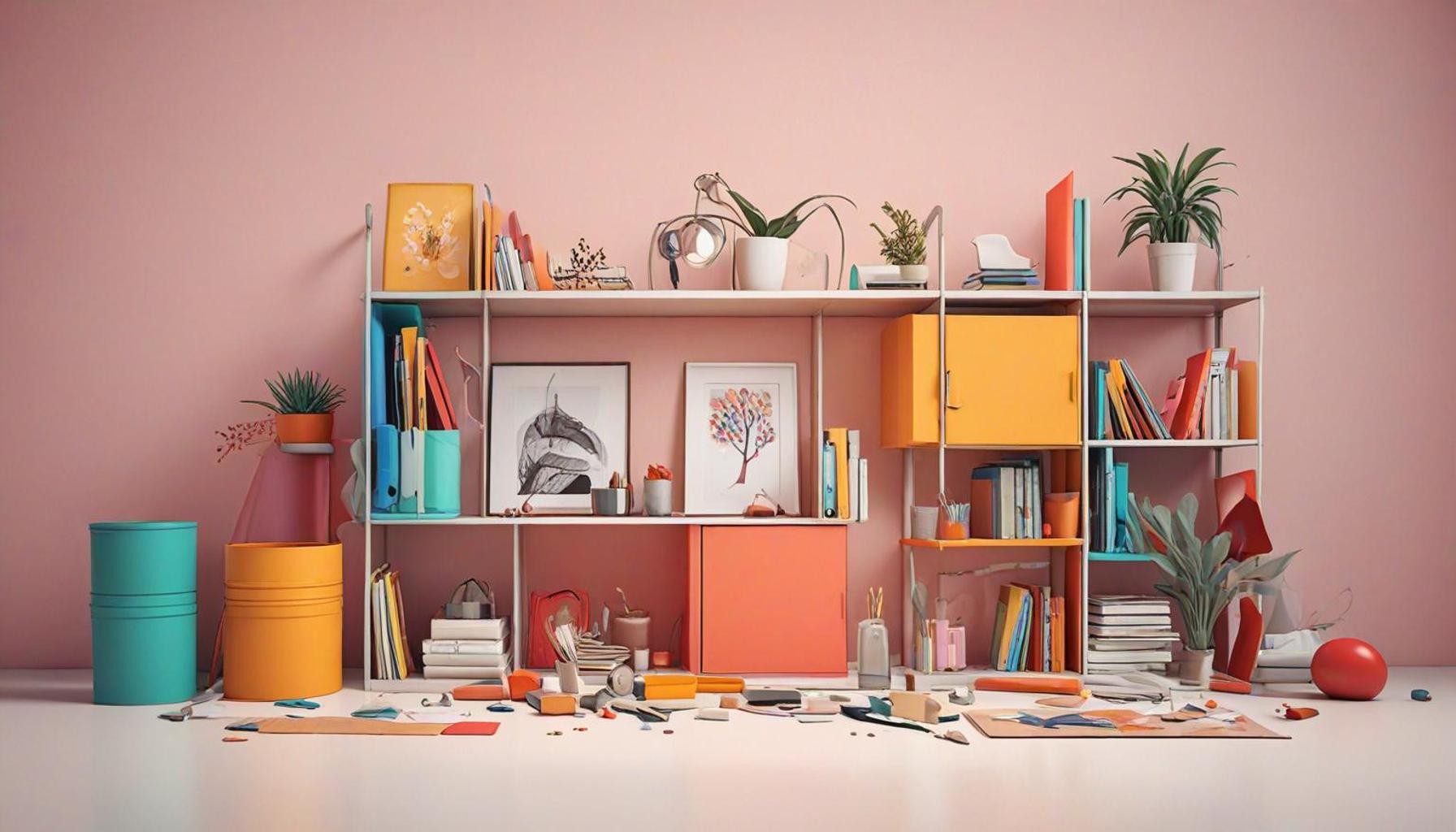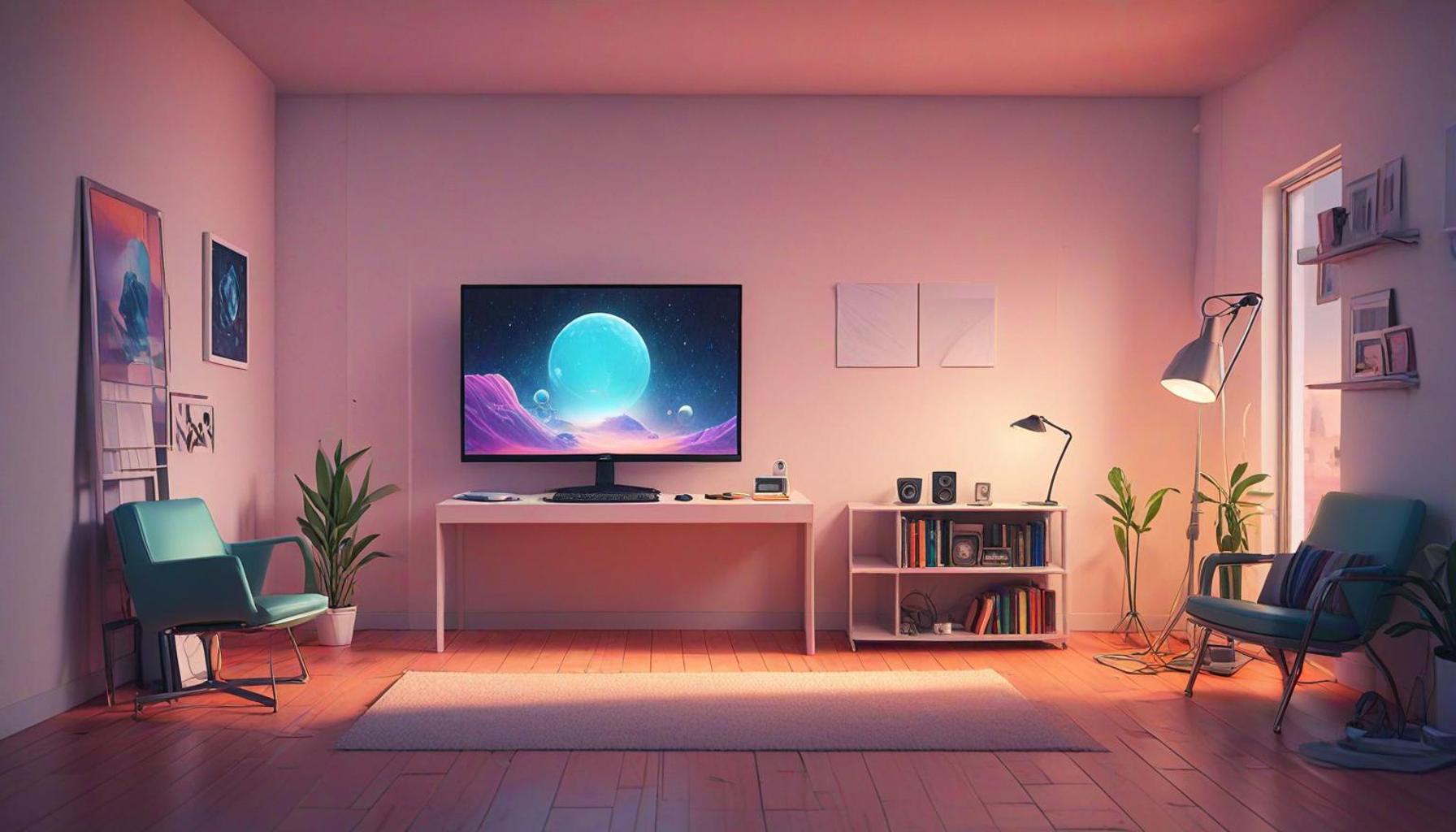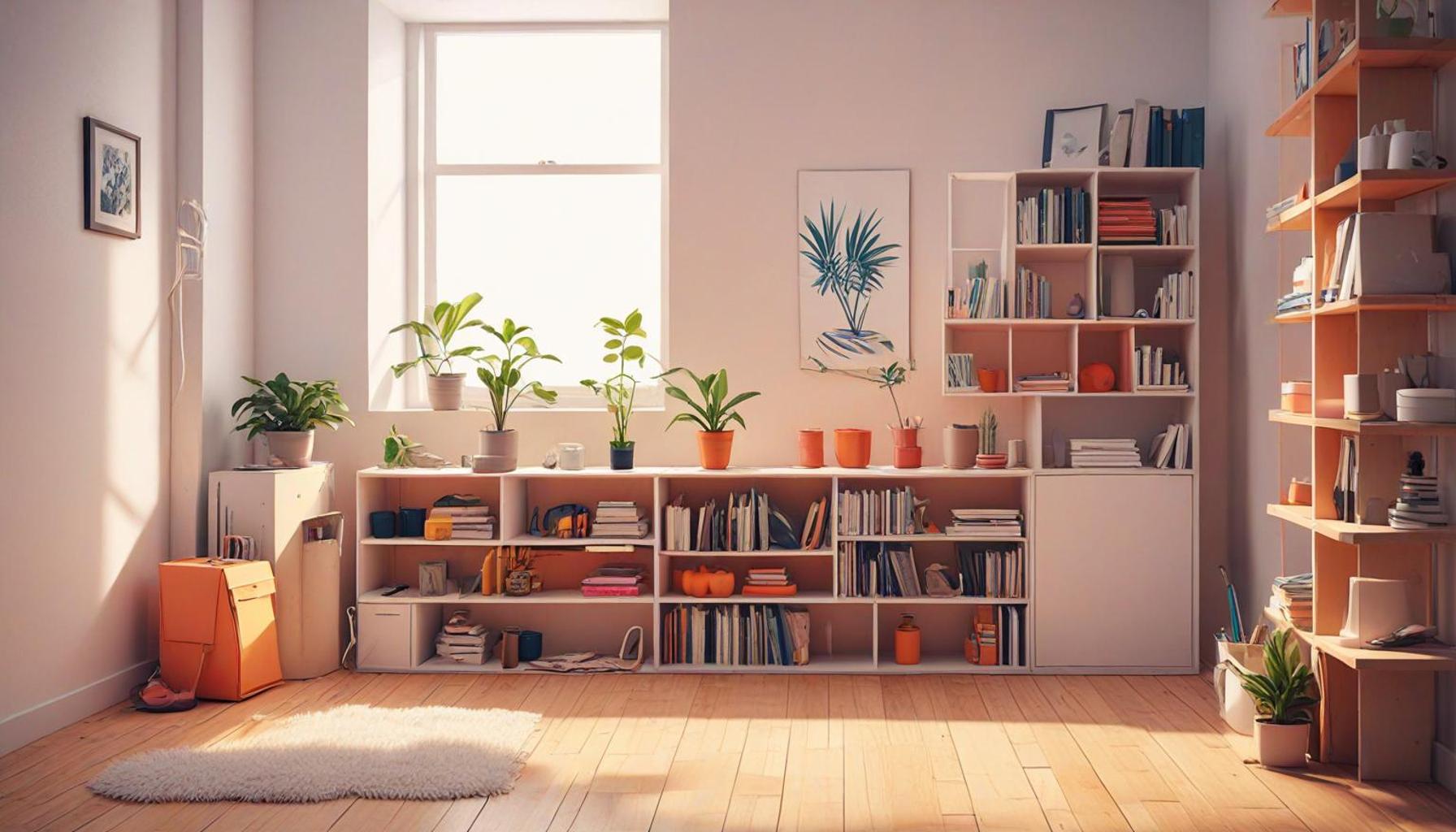How Spatial Efficiency Contributes to a Sustainable Minimalist Life

The Importance of Spatial Efficiency
In the face of escalating environmental challenges, such as climate change and resource depletion, the concept of spatial efficiency becomes increasingly vital. By refining how we utilize our physical space, we not only contribute to a healthier planet but also foster a more harmonious and fulfilling lifestyle. This transformation begins within our own homes, where small changes can lead to substantial shifts in our ecological and personal well-being.
Understanding Spatial Efficiency
Spatial efficiency primarily focuses on optimizing the available space to reduce clutter and encourage sustainable living. This approach urges individuals to analyze their possessions critically and embrace minimalism. When we reduce waste by curtailing unnecessary purchases, for instance, we subsequently lessen the demand for manufacturing processes that consume resources and generate pollution.
Enhancing energy efficiency is another crucial aspect of spatial efficiency. Living in smaller, well-designed spaces inherently lowers energy consumption for heating and cooling. According to the U.S. Department of Energy, homes that are 1,500 square feet or less can save an average of 30%-40% on energy costs compared to larger homes. This not only lightens the financial burden on residents but also mitigates their carbon footprint.
Promoting Mindful Living
In addition to environmental benefits, adopting a more spatially efficient lifestyle cultivates mindful living. A clutter-free environment enables mental clarity, allowing individuals to focus on what truly matters to them. Studies suggest that organized spaces can significantly reduce stress levels and increase productivity. By surrounding ourselves with fewer but more meaningful possessions, we create environments that inspire creativity and promote a sense of peace.
Innovative Solutions in Urban Settings
As urbanization continues to rise in cities across the United States, innovative solutions to spatial limitations are more relevant than ever. For example, multi-functional furniture, such as sofa beds, foldable tables, and storage ottomans, caters to the needs of smaller living spaces by maximizing functionality while minimizing clutter. This trend is particularly popular in metropolitan areas where space is at a premium.

Vertical gardens also offer an innovative approach to incorporate nature within restricted living environments. By utilizing walls to grow plants and herbs, urban dwellers can enjoy the psychological benefits of greenery while optimizing their limited space. These gardens not only improve air quality but also contribute to the overall aesthetic of a home.
Furthermore, shared community resources exemplify the spirit of collaboration and efficiency, encouraging neighbors to share tools, appliances, and communal spaces. Initiatives such as tool libraries and community gardens foster a sense of community while supporting the sustainable use of resources, reducing the need for each household to individually invest in seldom-used items.
The Path Forward
Implementing these strategies can significantly contribute to achieving a sustainable minimalist life. By optimizing our living environments, we not only conserve resources but also enhance our quality of life, proving that embracing spatial efficiency is not just a trend but a necessary evolution in how we approach modern living. Ultimately, a well-organized, functionally efficient space can lead to a more focused, joyful, and sustainable lifestyle, making it a worthwhile consideration for anyone looking to improve their environmental impact and personal happiness.
DISCOVER MORE: Click here to enhance your productivity
Unpacking the Impact of Space Utilization
A deeper understanding of spatial efficiency reveals its multifaceted benefits beyond simple organization. At its core, this concept encourages individuals to evaluate their spatial environments and make intentional choices about their belongings. Implementing spatial efficiency can lead to transformative changes in both individual households and communities at large.
Decluttering for a Sustainable Future
One of the most immediate benefits of enhancing spatial efficiency is the act of decluttering. This process involves sifting through possessions to identify what is truly necessary and meaningful. In an age where consumerism often reigns supreme, taking a step back to assess the role of each item in our lives can be profound. Consider engaging in the following steps:
- Evaluate Your Needs: Regularly assess what you use and value. If an item hasn’t served a purpose in the last year, it may no longer belong in your home.
- Embrace the ‘One In, One Out’ Rule: For every new item brought into the home, consider donating or discarding one existing possession.
- Prioritize Quality Over Quantity: Invest in fewer, high-quality items that are more sustainable and durable as opposed to fast fashion or disposable goods.
This method not only reduces clutter but also has significant ecological ramifications. By consciously choosing to purchase less, consumers can diminish the levels of waste generated at all stages of a product’s life cycle—from production to disposal. The environmental impact of this simple practice is tremendous, as it can lead to a decrease in greenhouse gas emissions associated with manufacturing, transportation, and waste management.
Streamlined Living and Its Benefits
Choosing to live in a more spatially efficient manner can also streamline daily routines, leading to increased productivity and satisfaction. Less clutter equates to less time spent managing belongings, which can free brainpower for activities that contribute to personal growth, creativity, and well-being. Research supports this notion, showing that individuals living in orderly environments tend to experience higher levels of happiness and fulfillment.
Additionally, spatial efficiency enables a more intentional relationship with our surroundings. When our spaces are optimized, they can serve multiple purposes, reducing the need for excess square footage. This strategy has the potential to reshape urban landscapes in a sustainable direction. For instance, opting for tiny homes or co-housing arrangements allows individuals to live comfortably while minimizing their environmental footprints.
Redefining Consumer Culture
Spatial efficiency is at odds with the cyclical nature of consumer culture, which promotes accumulation and excess. By shifting towards a minimalist mindset, we can redefine what it means to be satisfied and fulfilled. For many, finding joy in experiences rather than possessions can lead to a more meaningful life. As more individuals adopt this ethos, the cultural narrative begins to shift toward one that values sustainability and community over consumption.
In summary, embracing spatial efficiency plays a crucial role in cultivating a sustainable minimalist life. By examining our possessions through the lens of necessity and meaning, we can make deliberate decisions that yield positive environmental outcomes while enriching personal experiences. This conscious approach to living not only benefits individual households but can also create ripples throughout communities, encouraging a collective movement towards sustainability.
| Category | Advantages |
|---|---|
| Maximized Utility | Spatial efficiency ensures every square foot is utilized for essential purposes, reducing waste and promoting function. |
| Resource Optimization | It encourages minimal resource consumption, leading to lower energy bills and decreased environmental impact. |
| Decluttered Living Spaces | Promotes a peaceful atmosphere by minimizing excess items, facilitating cognitive clarity and mindfulness. |
| Enhanced Mobility | A more open layout allows for easier navigation, making homes more accessible and user-friendly. |
In the context of “How Spatial Efficiency Contributes to a Sustainable Minimalist Life,” understanding these advantages can motivate individuals to adopt such practices in their own lifestyles. Maximizing utility not only integrates the essentials into living spaces but also cultivates a philosophy centered around sustainability. This approach can stimulate profound changes, driving a shift away from consumerism towards a more sustainable existence. Moreover, by embracing resource optimization, households can significantly lower their carbon footprints. Such a transformation creates an opportunity for communities to come together, promote sustainable living, and reduce collective environmental impacts. In this ongoing journey towards minimalism, creating decluttered living spaces fosters not just physical tranquility but also mental wellness, exhibiting a clear link between spatial efficiency and healthier living.
DISCOVER MORE: Click here for tips on reducing stress through intentional living
Embracing Technological Innovations for Improved Efficiency
In today’s digital era, technology plays an instrumental role in enhancing spatial efficiency. Smart home devices and applications allow individuals to optimize their living spaces more effectively than ever before. With a myriad of options available, from space management apps to automated home systems, technology empowers us to better manage our environments, encouraging a minimalist lifestyle.
Smart Solutions for Optimizing Space
Utilizing technology can significantly ease the process of creating a more spatially efficient home. For instance, smart organization apps can help users catalog their belongings, track usage patterns, and remind them to declutter periodically. This proactive approach to household management not only streamlines the organization process but also fosters accountability. Additionally, augmented reality (AR) tools enable homeowners to visualize how new furniture or decor would fit into their space before making a purchase. The result is an informed decision-making process that prioritizes adaptability over accumulation.
Moreover, the rise of smart furniture—such as multifunctional tables, murphy beds, and modular seating solutions—demonstrates the innovative integration of spatial efficiency and design. These clever products are perfect for smaller living spaces, as they allow users to maximize their area without sacrificing comfort or aesthetic appeal. By leveraging smart technology and furniture, individuals can create versatile living environments that embody both style and functionality.
Sustainable Practices in Urban Settings
The influence of spatial efficiency extends beyond individual households, impacting broader urban dynamics as well. Cities across the United States are recognizing the importance of efficient land use to combat growing environmental concerns and population density. Innovative urban planning initiatives, such as mixed-use developments, prioritize sustainable living by integrating residential, commercial, and communal spaces into cohesive environments.
These developments not only help reduce the carbon footprint of residents but also foster a sense of community. For example, projects like Denver’s RiNo Art District illustrate how urban areas can be revitalized through adaptive reuse of old structures that prioritize minimalism and sustainability. This transformation is achieved by creating spaces where people can live, work, and play without relying heavily on transportation, ultimately promoting a more sustainable and connected lifestyle.
Cultivating a Mindful Community
As individuals increasingly adopt spatially efficient practices, a ripple effect occurs—encouraging local communities to advocate for sustainability and minimalism. Community-sharing initiatives, such as tool libraries and swap meets, allow residents to share resources rather than individually purchasing items that may only be used sporadically. In areas like Oakland, California, these sharing systems not only reduce waste but also strengthen community bonds.
Moreover, educational programs that highlight the benefits of spatial efficiency foster a culture of mindfulness toward consumption. In schools and community centers, workshops can engage individuals in evaluation exercises that challenge prevailing norms of consumerism. By equipping communities with the knowledge and skills to navigate their influence on the environment, spatial efficiency becomes a collective goal rather than an isolated endeavor.
Overall, enhancing spatial efficiency through technology, sustainable urban designs, and community engagement has the potential to transform not only individual lives but also entire neighborhoods. Each step toward a minimalist lifestyle contributes to a more sustainable future, fostering environments that prioritize resourcefulness, well-being, and connection.
DISCOVER MORE: Click here to simplify your finances
Conclusion: The Synergy of Spatial Efficiency and Sustainable Minimalism
In an age where environmental sustainability and minimalism are gaining unprecedented attention, spatial efficiency emerges as a pivotal element that can shape our lifestyles and urban landscapes. By embracing innovative technologies and smart home solutions, individuals can streamline their living spaces, allowing for a more mindful and intentional approach to consumption. This progress not only nurtures personal well-being but also systematically drives us toward a more sustainable future.
The integration of spatial efficiency in urban planning, as exemplified by projects like Denver’s RiNo Art District, showcases the potential for creating vibrant communities that prioritize both sustainable living and accessibility. These innovative developments reveal that when urban environments are designed with consideration for space and functionality, the results can be transformative—not just for the individual, but for the community as a whole.
Furthermore, as communities embrace shared resources and cultivate a culture of sustainability, the collective effort towards reducing waste and overconsumption becomes increasingly achievable. Initiatives like tool libraries in cities such as Oakland are powerful reminders that together, we can foster environments that prioritize collaboration over entitlement.
Ultimately, the journey toward a sustainable minimalist life is intertwined with spatial efficiency. By valuing our spaces and making conscious decisions about what we keep and how we live, we pave the way for a more responsible future. The path is not just about reducing physical clutter; it’s also about enriching our lives with clarity, purpose, and connection—a pursuit worth exploring for anyone keen on making a meaningful impact.



